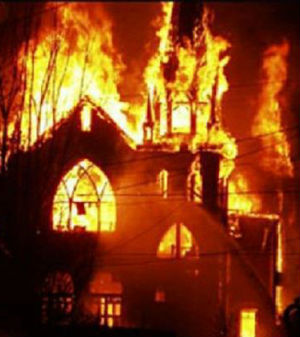
 |
Freethought & Rationalism ArchiveThe archives are read only. |
|
|
#1 | |
|
Contributor
Join Date: Mar 2003
Location: London UK
Posts: 16,024
|
https://www.facebook.com/pages/Abbay...e/176281465436
This comments about a saint of 250CE. anyone know about this Quote:
|
|
|
|
|
|
#2 | |
|
Contributor
Join Date: Jun 2000
Location: Los Angeles area
Posts: 40,549
|
 Saturnin was one of the "Apostles to the Gauls" sent out (probably under the direction of Pope Fabian, 236 - 250) during the consulate of Decius and Gratus (250-251) to Christianize Gaul after the persecutions under Emperor Decius had all but dissolved the small Christian communities. . . Saturnin was one of the "Apostles to the Gauls" sent out (probably under the direction of Pope Fabian, 236 - 250) during the consulate of Decius and Gratus (250-251) to Christianize Gaul after the persecutions under Emperor Decius had all but dissolved the small Christian communities. . . This all sounds quite dubious - a mishmash of story telling, legends, Mithraic themes: Quote:
|
|
|
|
|
|
#3 | |
|
Veteran Member
Join Date: Oct 2004
Location: Bordeaux France
Posts: 2,796
|
From this link :
http://www.philipcoppens.com/mithras.html Quote:
It is not possible to excavate anything from an existing Church, so, the idea that Notre Dame du Taur is built over a mithraeum cannot be controlled. A mithraeum has been found in Bordeaux in 1986, beneath a building which was under reconstruction. Inside it, there was the statue of a man with a lion's head. |
|
|
|
|
|
#4 | ||
|
Veteran Member
Join Date: May 2007
Location: Arizona
Posts: 1,808
|
Quote:
Quote:
As Moss notes, xtians seem to thrive on this idea that everyone is out to get them. |
||
|
|
|
|
#5 | |
|
Veteran Member
Join Date: Oct 2004
Location: Bordeaux France
Posts: 2,796
|
Another quote about Decius :
http://www.roman-emperors.org/decius.htm Quote:
|
|
|
|
|
|
#6 | ||
|
Veteran Member
Join Date: Apr 2002
Location: N/A
Posts: 4,370
|
Quote:
1. We have a bunch of ancient sources recording that a persecution took place under Decius, in which people like Origen were arrested and tortured. 2. We likewise have sources, including Pliny the Younger a century earlier, recording how Christians would not sacrifice. 3. We have a sudden demand that everyone should do so, and some of the certificates have been preserved. 4. No other group was at all likely to be affected. Why suppose anything other than what the sources say; that an anti-Christian policy was implemented? I do detest the falsification of history. |
||
|
|
|
|
#7 | |||
|
Veteran Member
Join Date: Sep 2004
Location: Birmingham UK
Posts: 4,876
|
Quote:
The fact that the legislation is not primarily designed to attack your religion does not stop it being persecution. Andrew Criddle |
|||
|
|
|
|
#8 | |||
|
Veteran Member
Join Date: Apr 2002
Location: N/A
Posts: 4,370
|
Quote:
Much of the Coppens article is factually in error, I notice. There are several churches in Rome where excavations under the floor were undertaken; notably San Clemente. Quote:
|
|||
|
|
|
|
#9 | |||
|
Veteran Member
Join Date: Apr 2002
Location: N/A
Posts: 4,370
|
Quote:
Quote:

|
|||
|
|
|
|
#10 | |
|
Veteran Member
Join Date: Apr 2002
Location: N/A
Posts: 4,370
|
Quote:
I wasn't clear whether the Acts of Saturninus existed or not. Some of the web pages I found rather suggested that they did, and had been augmented later. I can't find anything discussing what date they are. Looking into it and updating as I go... 1. There seems to be something in "Ruinart, Acta Martyrum sincera et selecta, p.109." Which I find in a second edition on p.128 f, here: (a list of mss used is p. lxxix). It's not that long a text. 2. I can't find any reference at all to these acts in JSTOR. 3. Possibly this work is BHL 7495-6. (?) 4. I've just asked a friend if they fancy translating the thing. 5. There is also a much longer 7-8th c. Passio S. Saturnini (BHL 7491), edited in 2002. 6. More details here. 7. Have found a French translation here (PDF). 8. Intro states: "In its current state, the Passion of St. Saturninus is a late text, reworked in the second decade of the 5th century (certainly before 450 AD), two centuries after the death of the bishop, at the moment when his cult took its essor (?) thanks to the translation of his relics from the modest tomb where he had been buried into a new basilica. The author of it is very definitely a clergyman of Toulouse living at the time of bishop Exuperius, or soon afterwards." |
|
|
|
| Thread Tools | Search this Thread |
|